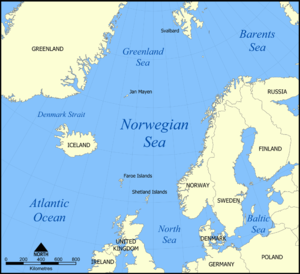- Northern Barrage
-
For the minefield laid in World War I, see North Sea Mine Barrage.
The Northern Barrage was the name given to an extensive series of defensive minefields laid by the British during World War II in order to restrict German access to the Atlantic Ocean. The barrage stretched from the Orkney to the Faroe Islands and on toward Iceland. Mines were also laid in the Denmark Strait, north of Iceland.[1]
Contents
Laying the barrage
In July 1939, before World War II had begun, the possibility of a Northern Barrage between the Orkney Islands and Norway (similar to that laid during World War I) had been investigated, however after the occupation of Norway by the Germans in April 1940 it was decided to position minefields between Orkney, the Faeroes and Iceland. Gaps would be left to allow passage of the fleet and convoys. In addition, mines were to be laid in the Denmark Strait, north of Iceland.[1]
The 1st Minelaying Squadron, based at Kyle of Lochalsh, was formed in June 1940, but the allocated ships were not available for minelaying until October. Lack of escorts and support problems also restricted operations, but 10,300 mines were laid at the southern end of the Faeroes-Iceland section before the end of the year.[1]
In 1941 work progressed on the with new fields laid north and south of the Faeroes as well as in the Denmark Strait. A refitting programme in U.S. ports was also implemented, but the work delayed by fog and gales. Intelligence reports in July indicated that U-boats were using the Faeroes-Iceland passage, so a series of deep anti-submarine fields were laid north-west of the Faeroes.[1]
In 1942 the value of the Northern Barrage was beginning to be questioned, though new fields were laid south of Iceland, before starting new deep fields on the Faeroes Bank. Magnetic mines were also laid in the Denmark Strait to replace earlier losses.[1]
The barrage is cancelled
The future of the Northern Barrage was discussed by the Admiralty at meetings in January and July 1943. The barrage had proved difficult to maintain as an effective barrier, and had already required over 80,000 mines. The work had also diverted badly needed ships from fleet and convoy defence in order to provide escorts for the minelayers. The Northern Barrage was described by the Commander-in-Chief of the Home Fleet as "the least profitable voluntary major undertaking of the war". The programme was cancelled and apart from the laying of an additional field at the entrance to Denmark Strait, the only future minelays approved were a series of deep fields at the northern end of the Faeroes-Iceland gap. On completion of the programme the 1st Minelaying Squadron was disbanded. A total of 92,083 mines had been laid, representing 35% of all British minelaying efforts, but the passage of U-boats had hardly been affected,[1] and only one submarine, U-647, was believed to have been sunk by it.[2] The Northern Barrage had failed to justify its existence and had often been more dangerous to Allied forces than to the enemy. Afterwards more effort was deployed on offensive minelaying by submarines, motor launches, and aircraft, which proved far more effective.[1]
References
- ^ "Type VIIC U-boat U-647". uboat.net. http://www.uboat.net/boats/u647.htm. Retrieved 12 January 2011.
External links
Categories:
Wikimedia Foundation. 2010.

